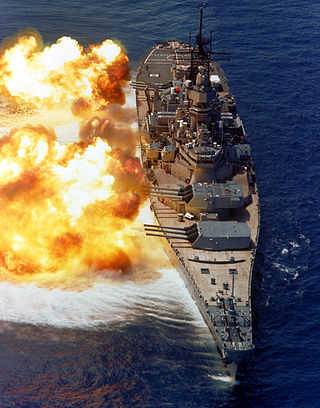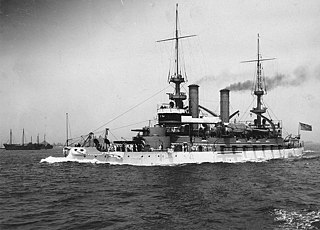
USS Oregon (BB-3) was the third and final member of the Indiana class of pre-dreadnought battleships built for the United States Navy in the 1890s. The three ships were built as part of a modernization program aimed at strengthening the American fleet to prepare for a possible conflict with a European navy. Designed for short-range operations in defense of the United States, the three Indiana-class ships had a low freeboard and carried a main battery of four 13-inch (330 mm) guns in a pair of gun turrets. Oregon and her sister ships were the first modern battleships built for the United States, though they suffered from significant stability and seakeeping problems owing to their small size and insufficient freeboard.

USS Indiana was the lead ship of her class and the first battleship in the United States Navy comparable to foreign battleships of the time. Authorized in 1890 and commissioned five years later, she was a small battleship, though with heavy armor and ordnance. The ship also pioneered the use of an intermediate battery. She was designed for coastal defense and as a result, her decks were not safe from high waves on the open ocean.

USS Iowa was a pre-dreadnought battleship built for the United States Navy in the mid-1890s. The ship was a marked improvement over the previous Indiana-class battleships, correcting many of the defects in the design of those vessels. Among the most important improvements were significantly better seaworthiness owing to her greater freeboard and a more efficient arrangement of the armament. Iowa was designed to operate on the high seas, which had been the impetus to increase the freeboard. She was armed with a battery of four 12-inch (305 mm) guns in two twin-gun turrets, supported by a secondary battery of eight 8-inch (203 mm) guns.

Maine was a United States Navy ship that sank in Havana Harbor on February 15, 1898, contributing to the outbreak of the Spanish–American War in April. U.S. newspapers, engaging in yellow journalism to boost circulation, claimed that the Spanish were responsible for the ship's destruction. The phrase, "Remember the Maine! To hell with Spain!" became a rallying cry for action. Although the Maine explosion was not a direct cause, it served as a catalyst that accelerated the events leading up to the war.

USS Massachusetts was an Indiana-class, pre-dreadnought battleship and the second United States Navy ship comparable to foreign battleships of its time. Authorized in 1890, and commissioned six years later, she was a small battleship, though with heavy armor and ordnance. The ship class also pioneered the use of an intermediate battery. She was designed for coastal defense and as a result, her decks were not safe from high waves on the open ocean.

USS Louisiana (BB-19) was a Connecticut-class battleship of the United States Navy. She was the second member of the class of six pre-dreadnought battleships, and the third ship to carry her name. Louisiana was laid down in February 1903, launched in August 1904, and commissioned in June 1906. She was a 16,000-long-ton (16,000 t) battleship capable of 19 knots. Her main armament consisted of four 12-inch (305 mm) guns supported by a mixed secondary battery of 7 in (178 mm) and 8 in (203 mm) guns.

New Hampshire (BB-25) was the sixth and final Connecticut-class pre-dreadnought battleship, the last vessel of that type built for the United States Navy. Like most contemporary battleships, she was armed with an offensive armament that consisted of four large-caliber 12-inch (305 mm) guns and several medium-caliber 7 and 8-inch guns. The ship was laid down in May 1905, launched in June 1906, and commissioned in March 1908, a little over a year after the revolutionary all-big-gun HMS Dreadnought rendered ships like New Hampshire obsolescent.

USS Washington (BB-47), a Colorado-class battleship, was the second ship of the United States Navy named in honor of the 42nd state. Her keel was laid down on 30 June 1919, at Camden, New Jersey, by the New York Shipbuilding Corporation. She was launched on 1 September 1921, sponsored by Miss Jean Summers, the daughter of Congressman John W. Summers of Washington.

USS Kearsarge (BB-5), was a pre-dreadnought battleship of the United States Navy and lead ship of her class of battleships. She was named after the sloop-of-war Kearsarge, famous for sinking the CSS Alabama, and was the only United States Navy battleship not named after a state.

USS Kentucky (BB-6), was the second and final Kearsarge-class pre-dreadnought battleship built for the United States Navy in the 1890s. Designed for coastal defense, the Kearsarge-class battleships had a low freeboard and heavy armor. The ships carried an armament of four 13-inch (330 mm) and four 8-inch (203 mm) guns in an unusual two-story turret arrangement. The Newport News Shipbuilding Company of Virginia laid down her keel on 30 June 1896. She was launched on 24 March 1898 and was commissioned on 15 May 1900.

The Indiana class was a class of three pre-dreadnought battleships launched in 1893. These were the first battleships built by the United States Navy comparable to contemporary European ships, such as the British HMS Hood. Authorized in 1890 and commissioned between November 1895 and April 1896, these were relatively small battleships with heavy armor and ordnance that pioneered the use of an intermediate battery. Specifically intended for coastal defense, their freeboard was insufficient to deal well with the waves of the open ocean. The turrets lacked counterweights, and the main belt armor was placed too low to be effective under most conditions.

The Iowa class was a class of six fast battleships ordered by the United States Navy in 1939 and 1940. They were initially intended to intercept fast capital ships such as the Japanese Kongō class while also being capable of serving in a traditional battle line alongside slower battleships and act as its "fast wing". The Iowa class was designed to meet the Second London Naval Treaty's "escalator clause" limit of 45,000-long-ton (45,700 t) standard displacement. Beginning in August 1942, four vessels, Iowa, New Jersey, Missouri, and Wisconsin, were completed; two more, Illinois and Kentucky, were laid down but canceled in 1945 and 1958, respectively, before completion, and both hulls were scrapped in 1958–1959.

The 16"/50 caliber Mark 7 – United States Naval Gun is the main armament of the Iowa-class battleships and was the planned main armament of the cancelled Montana-class battleship.

The Colorado-class battleships were a group of four United States Navy super-dreadnoughts, the last of its pre-Treaty battleships. Designed during World War I, their construction overlapped the end of that conflict and continued in its immediate aftermath. Though all four keels were laid, only three ships entered service: Colorado, Maryland, and West Virginia. Washington was over 75% completed when she was canceled under the terms of the Washington Naval Treaty in 1922. As such, the 16" gun Colorado-class ships were the last and most powerful battleships built by the U.S. Navy until the North Carolina class entered service on the eve of World War II.

The Kearsarge-class was a group of two pre-dreadnought battleships built for the United States Navy in the 1890s. The two ships—USS Kearsarge and USS Kentucky—represented a compromise between two preceding battleship designs, the low-freeboard Indiana class and the high-freeboard USS Iowa, though their design also incorporated several improvements. Their primary advances over earlier designs consisted of new quick-firing guns and improved armor protection, but their most novel feature was their two-story gun turrets that consisted of a secondary 8-inch (203 mm) gun turret fixed to the top of their primary 13-inch (330 mm) turrets. The ships suffered from a number of problems, however, including a tertiary battery mounted too low in the hull and poorly-designed turrets, though the latter were attempted again with the Virginia class in the early 1900s, also with negative results.

The Mississippi class of battleships comprised two ships which were authorized in the 1903 naval budget: Mississippi and Idaho; these were named for the 20th and 43rd states, respectively. These were the last pre-dreadnought battleships to be designed for the United States Navy, but not the last to be built, because one more ship of a prior design was completed later under the 1904 naval budget. While the quality and technology of the weaponry and armor were first-rate, these ships included a variety of main, intermediate, secondary, and tertiary gun sizes in a predreadnought configuration which became obsolete before the ships were completed.

The Pennsylvania class of six armored cruisers served in the United States Navy from 1905 to 1927. All six were renamed for cities 1912–1920, to make the state names available for the new battleships beginning with the Pennsylvania-class battleships. All of these served during World War I, with California being the only ship of the class to be lost. The remaining five armored cruisers were scrapped between 1930 and 1931 in accordance with the London Naval Treaty.

The Delaware-class battleships of the United States Navy were the second class of American dreadnoughts. With this class, the 16,000 long tons (16,257 t) limit imposed on capital ships by the United States Congress was waived, which allowed designers at the Navy's Bureau of Construction and Repair to correct what they considered flaws in the preceding South Carolina class and produce ships not only more powerful but also more effective and rounded overall. Launched in 1909, these ships became the first in US naval history to exceed 20,000 long tons (20,321 t).

The 16"/45 caliber Mark 6 gun is a naval gun designed in 1936 by the United States Navy for their Treaty battleships. It was introduced in 1941 aboard their North Carolina-class battleships, replacing the originally intended 14"/50 caliber Mark B guns and was also used for the follow-up South Dakota class. These battleships carried nine guns in three three-gun turrets. The gun was an improvement to the 16"/45 caliber guns used aboard the Colorado class, and the predecessor to the 16"/50 caliber Mark 7 gun used aboard the Iowa class.






















